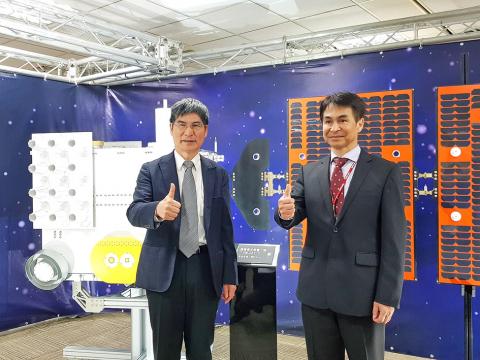The Ministry of Science and Technology yesterday announced plans to focus on the development of 10 small, high-resolution satellites for the third phase of the National Space Program.
The third phase, which is expected to cost NT$25.1 billion (US$814 million), was last month approved by Premier Su Tseng-chang (蘇貞昌).
It was the first official document he signed after taking office.

Photo: Chien Hui-ju, Taipei Times
It is to be executed by the National Applied Research Laboratories and the National Space Organization (NSPO) over a 10-year period starting this year, the ministry said.
The initiative would focus on the development of six prototype high-resolution optical remote sensing satellites, two ultra-high resolution smart optics remote sensing satellites and two synthetic aperture radar (SAR) satellites, it said.
It would also focus on the development of remote sensing technology and the use of smaller satellites to achieve higher resolution images, Minister of Science and Technology Chen Liang-gee (陳良基) said.
Citing an example, Chen said an ultra-high resolution smart optics remote sensing satellite weighing about 200kg would give users a 35cm view of the ground from an altitude of 510km, which would be the equivalent of spotting a cat or a dog in Pingtung County’s Kenting (墾丁) area from the Taipei 101 building.
The ministry plans to launch one satellite a year, he said, adding that the first is expected to be launched in 18 months.
The achievements of the first and second phases would serve as the foundation for the third phase, Chen said.
He hopes that the National Space Program would encourage innovation in the field of science, he added.
The prototype high-resolution optical remote sensing satellite constellation, which is to include three sets of two satellites, would raise the frequency of Formosat-5’s revisit rate from once every two days to twice or three times a day, NSPO director-general Lin Chun-liang (林俊良) said.
This would allow the ministry to gather more images, which has positive implications for the implementation of government policies, rescue missions, disaster prevention and scientific research, he said.
Ultra-high resolution smart optics remote sensing satellites focus on sub-meter resolution images, Lin said.
SAR satellites, which are equipped with active radar, are unaffected by cloud cover, fog or rainfall, which means they can function no matter the weather conditions or time of day, he said.
Other plans for the third phase include space exploration and the development of a satellite capable of orbiting the moon, Lin added.
As Taiwan lacks experience in these areas, it hopes to achieve its goal of space exploration by partnering with domestic and foreign academia, he said.
Having a satellite orbiting the moon would be the first step, he said.
Researchers would also explore ways to land a satellite on the moon, Lin added.
Without the assistance of GPS on the moon, the satellite would need to guide its own landing, he said.
Asked about the launch date of Formosat-7, Lin said that as Taiwan is partnering with the US for the launch, it would need to wait for the US to notify them.
Formosat-7’s six satellites are on standby at the NSPO, and can be packaged and delivered to the US as soon as it receives notice from the US, he said.
The ministry plans to launch Formosat-7 this year and a weather satellite called the “wind hunter” next year, Chen said.

An essay competition jointly organized by a local writing society and a publisher affiliated with the Chinese Communist Party (CCP) might have contravened the Act Governing Relations Between the People of the Taiwan Area and the Mainland Area (臺灣地區與大陸地區人民關係條例), the Mainland Affairs Council (MAC) said on Thursday. “In this case, the partner organization is clearly an agency under the CCP’s Fujian Provincial Committee,” MAC Deputy Minister and spokesperson Liang Wen-chieh (梁文傑) said at a news briefing in Taipei. “It also involves bringing Taiwanese students to China with all-expenses-paid arrangements to attend award ceremonies and camps,” Liang said. Those two “characteristics” are typically sufficient

A magnitude 5.9 earthquake that struck about 33km off the coast of Hualien City was the "main shock" in a series of quakes in the area, with aftershocks expected over the next three days, the Central Weather Administration (CWA) said yesterday. Prior to the magnitude 5.9 quake shaking most of Taiwan at 6:53pm yesterday, six other earthquakes stronger than a magnitude of 4, starting with a magnitude 5.5 quake at 6:09pm, occurred in the area. CWA Seismological Center Director Wu Chien-fu (吳健富) confirmed that the quakes were all part of the same series and that the magnitude 5.5 temblor was

The brilliant blue waters, thick foliage and bucolic atmosphere on this seemingly idyllic archipelago deep in the Pacific Ocean belie the key role it now plays in a titanic geopolitical struggle. Palau is again on the front line as China, and the US and its allies prepare their forces in an intensifying contest for control over the Asia-Pacific region. The democratic nation of just 17,000 people hosts US-controlled airstrips and soon-to-be-completed radar installations that the US military describes as “critical” to monitoring vast swathes of water and airspace. It is also a key piece of the second island chain, a string of

The Central Weather Administration has issued a heat alert for southeastern Taiwan, warning of temperatures as high as 36°C today, while alerting some coastal areas of strong winds later in the day. Kaohsiung’s Neimen District (內門) and Pingtung County’s Neipu Township (內埔) are under an orange heat alert, which warns of temperatures as high as 36°C for three consecutive days, the CWA said, citing southwest winds. The heat would also extend to Tainan’s Nansi (楠西) and Yujing (玉井) districts, as well as Pingtung’s Gaoshu (高樹), Yanpu (鹽埔) and Majia (瑪家) townships, it said, forecasting highs of up to 36°C in those areas